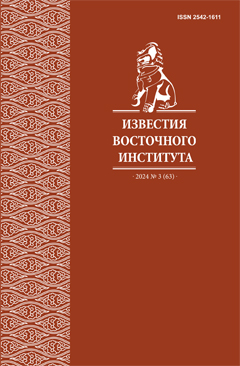Language planning in Japan from the mid XIX to the early XXI century
DOI:
https://doi.org/10.24866/2542-1611/2024-3/123-136Keywords:
language planning, language policy, language situation, written languages in Japan, language situation in the Meiji era, actors of language planning, reforming the Japanese language, kanji limitsAbstract
The article examines language planning in Japan from the second half of the XIX century to the beginning of the XXI century. It analyzes changes in the linguistic situation, identifies the key actors of language planning, as well as legislative acts of the Japanese government that turned various elements of language planning into an organized system of state policy. Special attention is focused on the Meiji era and language reforms after World War II, when changes to the Japanese language were stimulated by powerful popular movements. At other times, as well as at present, language planning has been under strict control of the Japanese government and has been primarily limited to its language policy. Additionally, the article provides a brief overview of language planning and policy issues in Japan on occupied territories during World War II. It also highlights the key features of the contemporary linguistic situation and the current tasks of language policy and planning in Japan in the XXI century.
Downloads
References
Васильева Л.В. Языковая политика Японии с периода Мэйдзи до наших дней // Япония: 150 лет революции Мэйдзи. Серия: "Issues Of Japanology = Вопросы японоведения". Санкт-Петербург: Эйдос, 2018. С. 630–667.
Дыбовский. А.С. Заимствования в японском языке и процессы европеизации японского общества // Россия и АТР. 1996. № 3. С. 97–102.
Дыбовский А.С. Идеология японоцентризма в учебной литературе по японскому языку. На материале учебников японского языка эпохи японской оккупации английских владений в Малайе и Сингапуре (1941–1945) // Историческая и социально-образовательная мысль. 2020. Том 12. № 1. С. 54–72.
Дыбовский А.С. О дискурсивных особенностях использования западных заимствований в современном японском языке (новая редакция) // Педагогика: история, перспективы. 2022.Toм 5. No 4. С. 119–135.
Дыбовский А.С. Японский язык как арена столкновения цивилизаций // Дальневосточный филологический журнал. 2023. Т. 1. No 4. С. 17–30. URL: https://journals.dvfu.ru/dvphilology/article/view/963/683/ (дата обращения: 18.01.2024).
Прасол А.Ф. Японское образование в эпоху Мэйдзи (1868–1912). Владивосток: Дальнаука, 2002. 357 с.
Language Planning in the Soviet Union / Edited by Mikhael Kirkwood. London: The Macmillan Press LTD, 1989. 230 p.
Nanette Gottlieb. Language policy in Japan. Cambridge university press, 2012. 207 p.
当用漢字表 / 国語施策・日本語教育=Таблица общеупотребимых иероглифов / Языковая политика. Преподавание японского языка. URL: https://www.bunka.go.jp/kokugo_nihongo/sisaku/joho/joho/kakuki/syusen/tosin02/index.html/ (дата обращения: 03.05.2024).
野村敏夫 国語政策の戦後史 大修館店 東京 =Тосио Номура. Послевоенная история языковой политики Японии. Токио. Изд-во Тайсюкан. 2006. 292 p.
旧吉田茂邸大磯町郷土資料館 =Музей-резиденция бывшего премьер-министра Ёсида Сигэру. Архивный зал на родине в районе Исо. URL: http://www.town.oiso.kanagawa.jp/oisomuseum/kyuyoshidatei/lab/R3/16519.html/ (дата обращения: 03.05.2024).
日本語の中の外来語と外国語 ―新聞,雑誌,テレビ ― =Западные заимствования и иностранные слова в японском языке: газеты, журналы, ТВ / 第 30 回「ことば」フォーラム =Тридцатый форум "Язык" / 独立行政法人国立国語研究所 =Независимое юридическое лицо / Государственный институт родного языка. URL: https://www2.ninjal.ac.jp/past-events/kotoba_forum/30/haihu_30.pdf/ (дата обращения: 28.04.2024).
志賀直哉 =Сига Наоя // Wikipedia. URL: https://ja.wikipedia.org/wiki/志賀直哉/ (дата обращения: 30.04.2024).
森有礼 =Мори Аринори // Wikipedia. URL: https://ja.wikipedia.org/wiki/森有礼/ (дата обращения: 30.04.2024).
福澤諭吉 =Фукудзава Юкити // Wikipedia. URL: https://ja.wikipedia.org/wiki/福澤諭吉/ (дата обращения: 30.04.2024).
二葉亭四迷 =Футабатэй Симэй // Wikipedia. URL: https://ja.wikipedia.org/wiki/二葉亭四迷/ (дата обращения: 03.05.2024).
船橋洋一 英語公用語論の思想 // 言語 8月号 =Фунасаба Ёити. Некоторые идеи по поводу английского языка в качестве официального // Язык. 2000. Том. 29, № 8 (347). С. 22–27.
放送法 // 衆議院 =Закон о вещании // Палата Представителей. URL: https://www.shugiin.go.jp/internet/itdb_housei.nsf/html/houritsu/00719500502132.htm/ (дата обращения: 30.04.2024).
Vasilieva L.V. Language Policy of Japan from the Meiji Period to the Present Day // Japan: 150 Years of Meiji Revolution. Series: "Issues of Japanology". St. Petersburg: Eidos, 2018. P. 630–667 (In Russ.).
Dybovsky A.S. Loanwords in the Japanese Language and the Processes of Europeanization of Japanese Society // Russia and the Asia-Pacific Region. Publisher: Institute of History, Archaeology and Ethnography of the Far Eastern Branch of the Russian Academy of Sciences, 1996, No. 3. P. 97–102 (In Russ.).
Dybovsky A.S. The Ideology of Japanocentrism in Textbooks of Japanese Language During the Japanese Occupation of British Territories in Malaya and Singapore (1941–1945) // Historical and Socio-Educational Thought. Vol. 12. No. 1. 2020. P. 54–72 (In Russ.).
Dybovsky A.S. On the Discursive Features of the Use of Western Loanwords in Contemporary Japanese Language (Revised Edition) // Pedagogy: History, Perspectives. Vol. 5. No. 4. 2022. P. 119–135 (In Russ.).
Dybovsky A.S. Japanese Language as an Arena of Civilization Clash // Far Eastern Philological Journal. 2023. Vol. 1. No. 4. P. 17–30. Electronic resource. URL: https://journals.dvfu.ru/dvphilology/article/view/963/683/ (accessed 18.01.2024) (In Russ.).
Prasol A.F. Japanese Education in the Meiji Era (1868–1912). Vladivostok: Dalnauka, 2002. 357 p. (In Russ.).
Language Planning in the Soviet Union / Edited by Mikhael Kirkwood / London: The Macmillan Press LTD, 1989. 230 p.
Nanette Gottlieb. Language policy in Japan / Cambridge university press 2012. 207 p.
Official List of Commonly Used Kanji Characters / National Language Policies and Japanese Language Education. URL: https://www.bunka.go.jp/kokugo_nihongo/sisaku/joho/joho/kakuki/syusen/tosin02/index.html (accessed 03.05.2024) (In Jap.).
Nomura, Toshio. Postwar History of National Language Policy. Daishukan-ten, Tokyo, 2006. 292 p. (In Jap.).
Former Residence of Yoshida Shigeru, Oiso Town Local History Museum. URL: http://www.town.oiso.kanagawa.jp/oisomuseum/kyuyoshidatei/lab/R3/16519.html/ (accessed 03.05.2024) (In Jap.).
Loanwords and Foreign Languages in Japanese – Newspapers, Magazines, Television – / 30th "Language" Forum / National Institute for Japanese Language and Linguistics. URL: https://www2.ninjal.ac.jp/past-events/kotoba_forum/30/haihu_30.pdf/ (accessed 30.04.2024) (In Jap.).
Shiga Naoya // Wikipedia. URL: https://ja.wikipedia.org/wiki/志賀直哉/
(accessed 30.04.2024) (In Jap.).
Mori Arinori // Wikipedia. URL: https://ja.wikipedia.org/wiki/森有礼/ (accessed 30.04.2024) (In Jap.).
Fukuzawa Yukichi // Wikipedia. URL: https://ja.wikipedia.org/wiki/福澤諭吉/ (accessed 30.04.2024) (In Jap.).
Futabatei Shimei // Wikipedia. URL: https://ja.wikipedia.org/wiki/二葉亭四迷/ (accessed 03.05.2024) (In Jap.).
Funabashi Yōichi / The Idea of English as an Official Language // Gengo, August Vol. 29, No. 8 (347), 2000. P. 22–27. (In Jap.).
Broadcasting Act // House of Representatives / URL: https://www.shugiin.go.jp/internet/itdb_housei.nsf/html/houritsu/00719500502132.htm/ (accessed 30.04.2024) (In Jap.).




